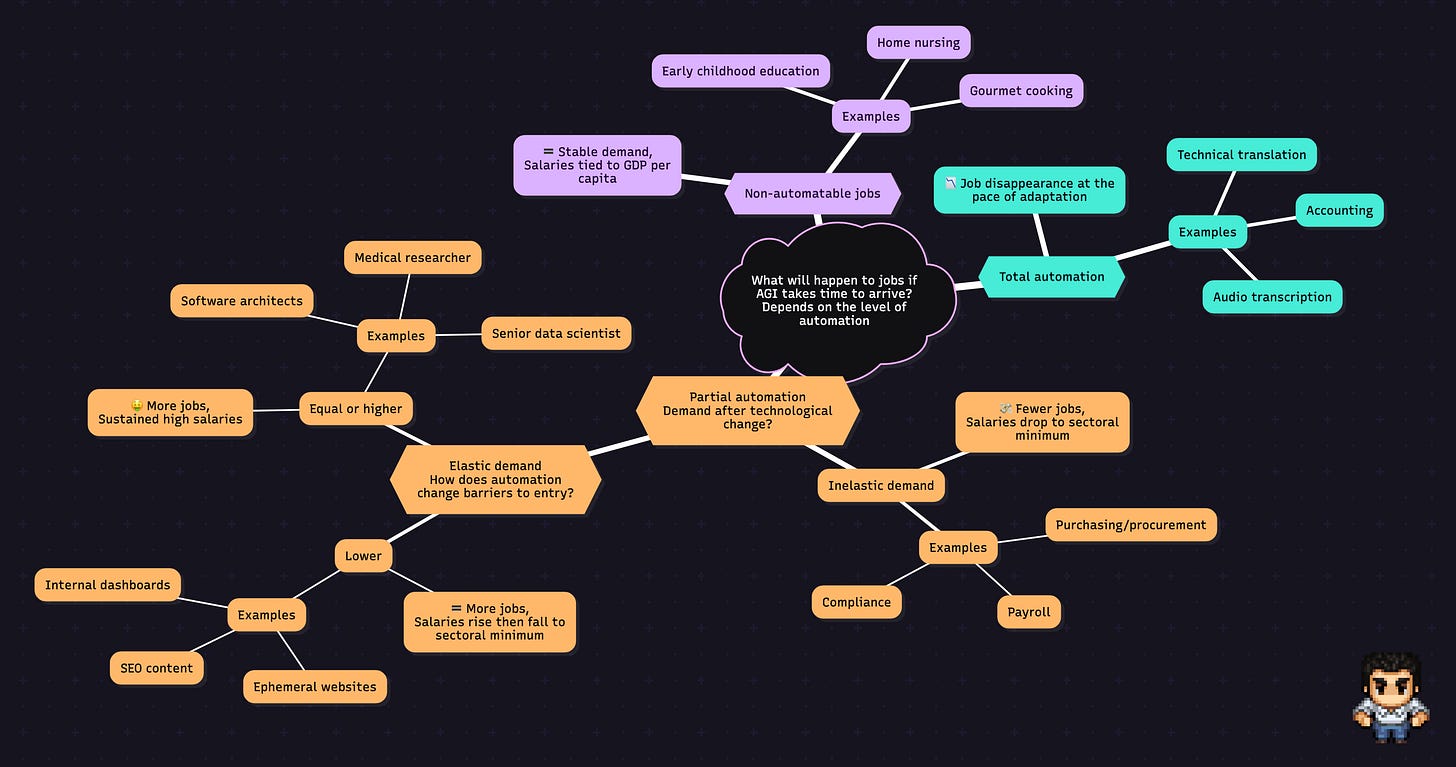My current guess at the effect of AI automation on jobs
All models are wrong,
but some models are useful.
—George Box
This is my current guess at the effect of AI automation on the job market for the following years. I know it’s oversimplified and wrong but it might be useful to share it.
I’m going to assume that AI will automate many tasks over the next decade or decade and a half. That means some job positions will be fully automated, but many more will be partially automated. It’s not as if the job market will continue with its current dynamics until everyone is unemployed at once.
For scenarios with very short AI timelines, there is no time to react—so I’ll disregard those.
The first question that my simplified model asks is: “What level of automation do you expect for a given occupation?”.
Non-automatable jobs
The demand for these positions won’t change much. It might increase organically as GDP grows due to automation in the rest of the economy, or decrease if consumer preferences shift.
I expect compensation to track the GDP growth, but not exceed it. There is a well known effect, named Baumol effect, in which productivity increases in some occupations produce salary increases in the rest of them.
Not a bad place to be—but also not the best.
Total automation
These jobs will disappear at the pace society can adapt. This could be very fast for non-unionized workers in jurisdictions without strong job protections, or very slow for well-protected workers in countries like Spain or France, and in the civil service, which can remain insulated from reality indefinitely.
I would look for greener pastures in other branches of the tree.
Partial automation
The impact of partial automation can be positive or negative, depending on two other variables:
Elasticity of the demand
Changes to the barriers of entry post-automation
“Elasticity” is economics jargon for how responsive demand is to price changes. For example, if technology automates 50% of a job’s tasks, the output per salary dollar nearly doubles. Think of a tax consultant using an LLM agent to double the number of tax reports completed daily. Her clients aren’t going to report to file taxes twice a year just because it’s now cheaper—this is inelastic demand.
The opposite happens when you can build software for half the cost. Many niches become profitable, and investment in software development can more than double. This is an example of elastic demand (and an example of the Jevons Paradox).
Inelastic demand
As exemplified by the tax consultant, these jobs will shrink, but not as quickly as fully automatable ones. Other examples include purchasing clerks, procurement officers, compliance roles, payroll, etc.
The phrase “AI won't replace you, someone using AI will” is false in general but true for this category. If my job were here, I’d adopt AI tools early—to outcompete my peers or pivot to another branch of the tree.
Elastic demand
If the demand is elastic, the outcome depends on what happens to the barriers of entry after the tech shift.
One interesting case is computer programming, which I think will bifurcate:
Vibe coders: They don’t inspect or care about the code; they just prompt the model until features appear. If something breaks, they either start over or move to another problem. The barrier to entry is much lower than for pre-LLM programming. This will boost global productivity—but it’s limited to throwaway, non-critical, narrow-scope projects.
Augmented coders: These people care deeply about the generated code. They collaborate with and guide the coding agent (or "genie," as Kent Beck calls it). This requires solid architectural judgment and deep domain knowledge. The barrier to entry is at least as high—possibly higher—than in traditional programming.
I expect salaries to rise initially in both cases. But the high pay for low-barrier jobs will attract a flood of entrants, driving compensation back to normal levels. Meanwhile, for high-barrier roles, salaries will likely stay elevated—or rise even further.
If you’re in a partially automatable job with high demand elasticity and sustained or increased entry barriers—congratulations!
If not, ask Deep Research on the lowest-cost path from where you are to one of these occupations. Or read this excellent article by 80,000 Hours.




Updated to link the Baumol effect.